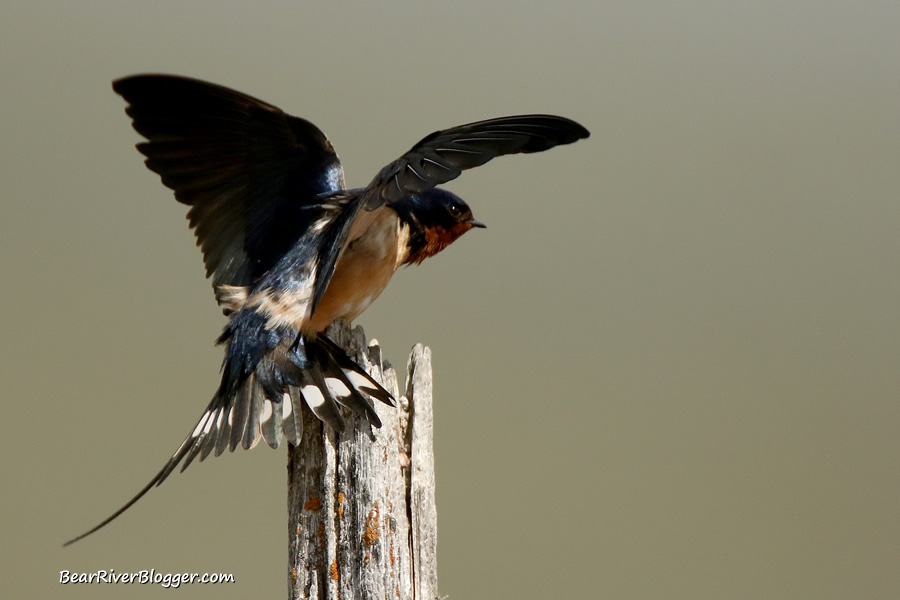If you have barn swallows in the yard each summer, you’ve probably experienced a time or two where they dive-bomb you as you walk around the house somewhere. It happened to me this summer when a pair of barn swallows built their nest right above the garage door on a light fixture.
Not the best location for a bird nest I can assure you, but they’ve actually tried nesting there the past couple of years with no success at all. I admire their determination, though, as each year, just like the reliability of a well-machined clock, the swallows return and once more start the process all over again.
This summer, though, things ended up a bit different for my small feathered friends. Each evening when I would take out the garbage, I would have to literally walk right under their humble abode.
At first, not much happened as they were just casually coming and going with their daily chores. The nest was slowly but surely growing day by day, and my new tenants seemed to put up with an occasional intrusion into their space while I was just enjoying their company in the yard.
One day, things quickly changed and I knew something was up with the nest. I came around the corner and one of the barn swallows dove at me, and it continued to dive at me until I finished my task and went back inside the house.
It then occurred to me that I might have an active nest and the swallows are most likely sitting on eggs. As it turned out, I was right, they were on an active nest.

In fact, they ended up successfully raising two baby swallows from that small bowl of mud precariously built on a light fixture right above my garage door this past summer.
Barn swallows have a strong instinct to protect their young, and these tenacious little birds will dive at anyone that gets too close to their nest in order to protect it and young.
They will dive-bomb you even when there are only eggs in the nest, and I have even had them dive at me during their nest-building process as well a time or two.
I have never actually been hit by a barn swallow diving at me, but I have had them come within a couple of feet of me plenty of times.
Fortunately, the territory a barn swallow on a nest is pretty small. Once I was a few yards away from the nest, the birds calmed down and stopped harassing me.
Other birds, such as cooper’s hawks, aren’t so forgiving, though. I have had them nest in a previous yard, and once the eggs hatched, they would dive and harass me anywhere in the yard until the young hawks left the nest.
What to do
When a barn swallow dives at you, the only thing you can really do is just leave the area and avoid it until the baby swallows leave the nest. They are only doing what their natural instinct is telling them to do, protect the nest, and guard their young.
We certainly can’t fault them for this, but it can be a nuisance to be harassed by birds when you are just going about your daily business. The easiest thing to do is to just avoid the area, if at all possible until the young birds fledge and go their own way.
Barn swallows have an incubation period that is about 13-17 days long, and it takes another 18-23 days before the young birds are old enough to leave the nest. This means once they lay their eggs, it will be about 5 weeks or so before they are done with their nesting duties.
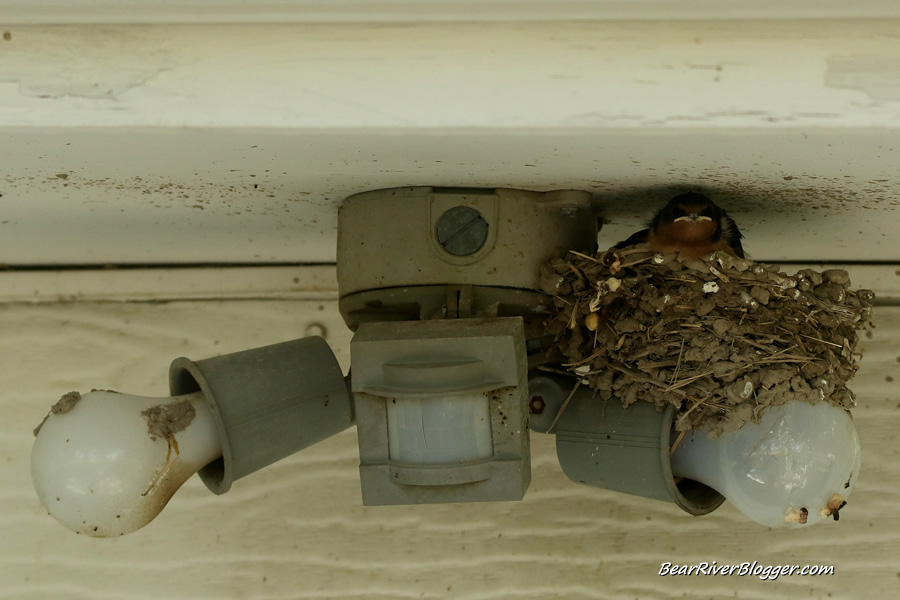
That is how long you may have to put up with this unruly but natural behavior. In some warmer climates with longer summers, however, barn swallows may have another clutch of eggs. So if you live in one of these areas, just keep that in mind.
Taking down an active migratory bird nest is not only discouraged but is against the law. Migratory birds are protected by federal law, and their nests, eggs, and young cannot be disturbed during nesting season.
Discourage nesting
If you’re like me and you have yearly barn swallows returning to your property, the best thing to do is to try and discourage nesting in areas where there is high human traffic and activity.
Preventing a nest in a high traffic spot is about the only thing we can really do as taking down active nests is illegal, and if it’s early in the breeding season, the birds might attempt to rebuild the nest anyway.
Start off by keeping garage doors closed to discourage nesting inside the garage. I have had this problem before and solved it by simply keeping a door shut during spring and summer.
Plastic spikes can also be used with some success to discourage nesting. I have seen this work on the Bear River Migratory Bird Refuge the past couple of years, and it does indeed help.
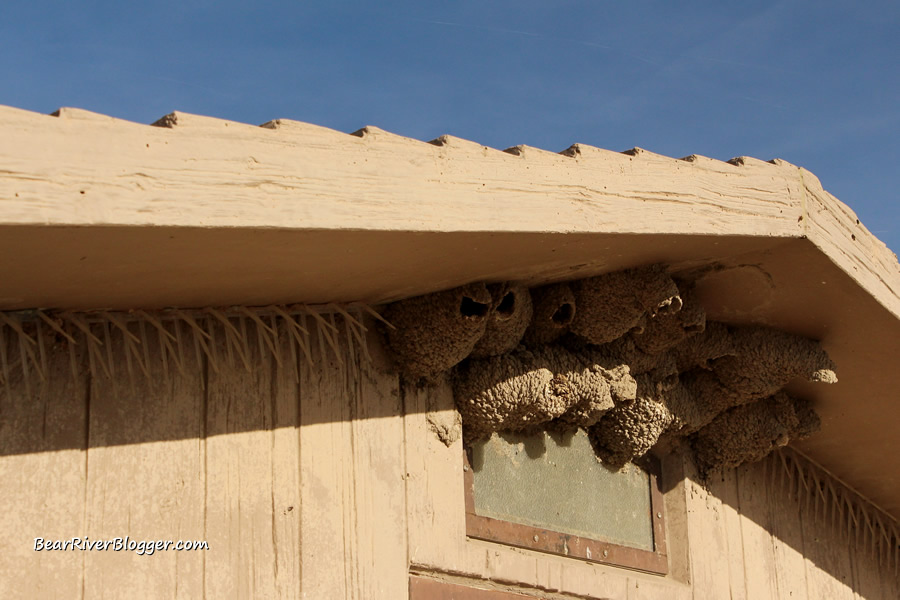
Each year, barn swallows would build nests up under the eaves of the restroom facilities, but strips of plastic spikes placed in strategic locations have deterred most of this nesting activity.
You can also try putting up a nest box in a different location around the house to encourage nesting away from high traffic areas. Barn swallows nest around and on man-made structures, so put the nest up under the eaves but away from doors or areas commonly used.
Taking down a previous year’s nest doesn’t really discourage barn swallows from building a new nest in the same spot. The only thing that helps is discouraging them from using that spot and offering a different location instead. It might not always work, but it’s worth a try.
About barn swallows
Barn swallows are some of the most interesting migratory birds in North American. I say this because of how much time they spend on the wing and how far they have to fly during migration.
In spring, barn swallows migrate thousands of miles from Central and South America to their breeding grounds all across North America, as far north as Canada, and even a bit into Alaska at times.
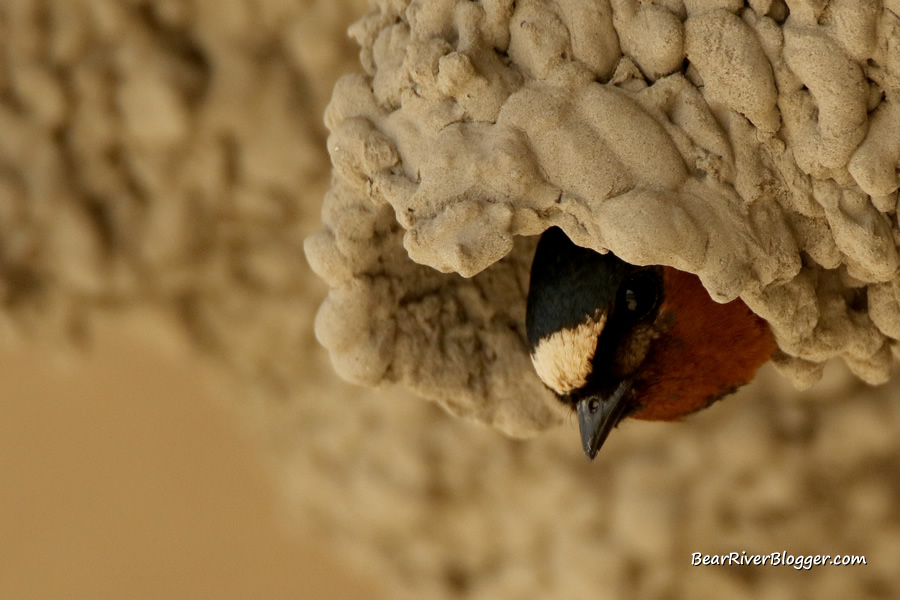
They build their nests with mud and can be observed picking up beak-fulls of it to take back to the nest. Locations around man-made structures such as homes, sheds, barns with eaves, crossbeams, and rafters are where you will find them trying to build a nest, which is why they can be a bit of a pest at times.
During the day, swallows spend a lot of time in flight, soaring around the yard catching flies and other insects such as beetles, bees, wasps, butterflies, and moths for a meal and to take back to their young.
Do swallows come back every year?
It has been said barn swallows return to the same spot every year and can, in fact, use the same nest from a previous year unless it’s heavily infested with mites or parasites. Because of this, taking down nests from previous years won’t discourage a barn swallow from rebuilding a nest in the same location.
I can attest to this, myself. For several years after I moved to my current house, barn swallows would return to my yard and try to build a nest inside my garage, right above the doorbell of all places.
This happened like clockwork for about 4 years or more, and I can only assume it was the same birds from previous years that knew of this exact spot inside of my garage.
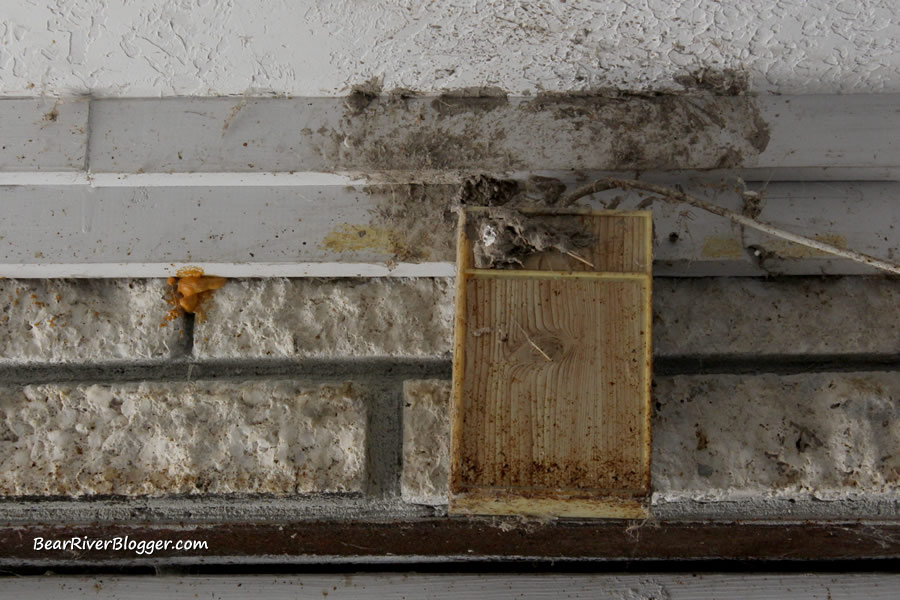
Attracting barn swallows.
It might seem a bit counter-intuitive to be talking about how to attract barn swallows to your yard on a blog post about why they dive-bomb people, but barn swallows are a beneficial bird to have around.
They eat a lot of flies and other large insects and are also very entertaining to watch as they fly around the yard in search of food and tend to their nest.
If you are so inclined to try and encourage barn swallows to nest in your yard, try putting up a nest box. The Cornell Lab of Ornithology has a great website with plans on how to build an appropriate sized barn-swallow nest box, including a few helpful tips on where to locate the box.
Barn swallows need mud to build their nest. Use a garden hose to regularly keep a bare piece of ground in your yard wet and muddy for these birds to come and use the mud for nest building purposes.
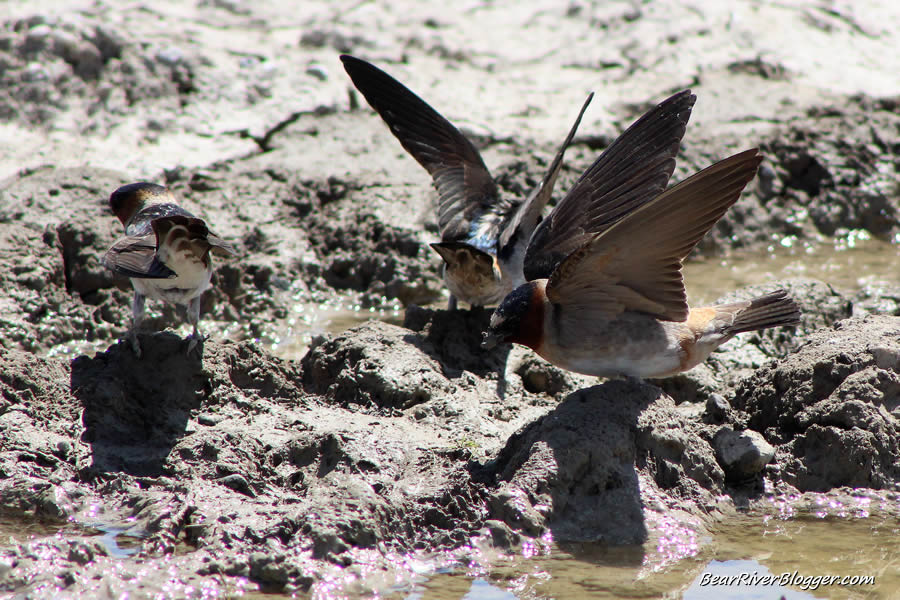
Barn swallows on the Bear River Migratory Bird Refuge
I like barn swallows and enjoy them coming to my property each summer. I only get one pair in my yard, but they are fascinating birds and entertaining to have around.
The Bear River Migratory Bird Refuge attracts thousands of barn swallows each summer, and they can be seen building nests on just about any man-made structure out on the refuge, including the restrooms, water control structures, kiosks, and the visitors center building itself.
One afternoon while driving the auto tour route, I came across two young barn swallows sitting on a sign. After not having much luck finding other birds to photograph, I decided to stay and watch these young swallows, and I learned something very interesting in the process.
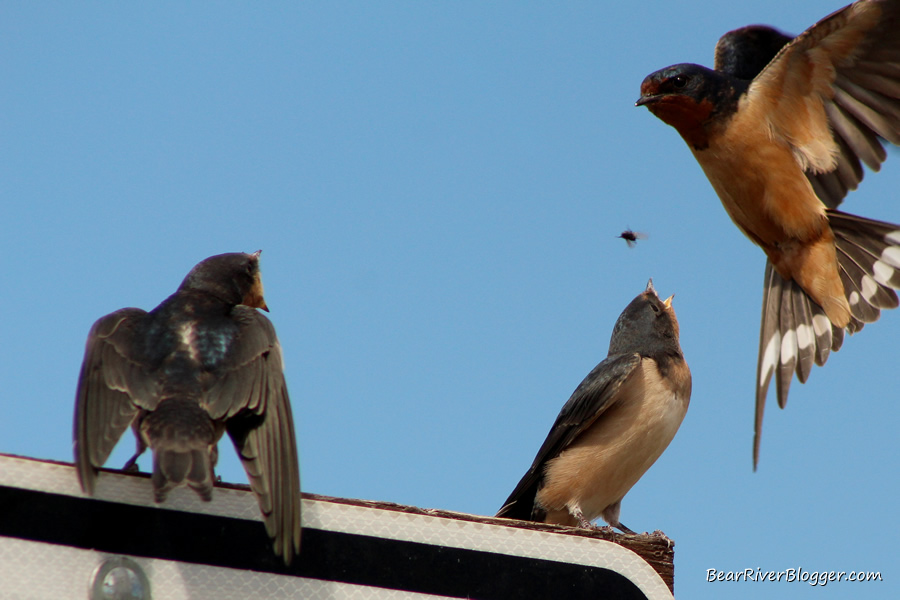
I sat with the swallows for what seemed like an hour or more, observing and photographing them at times. Occasionally, one of the parents would fly by and offer food to the young birds.
I was able to photograph the parents not only dropping flies for the baby swallows to catch, but I also photographed an adult swallow offering a fly to one of the young birds, beak-to-beak, while still in flight.
I had no idea barn swallows fed their young this way, and it was a very educational experience for me. But that is why I like bird watching so much, I always seem to come home learning something I have not known before, just from observing birds being birds.
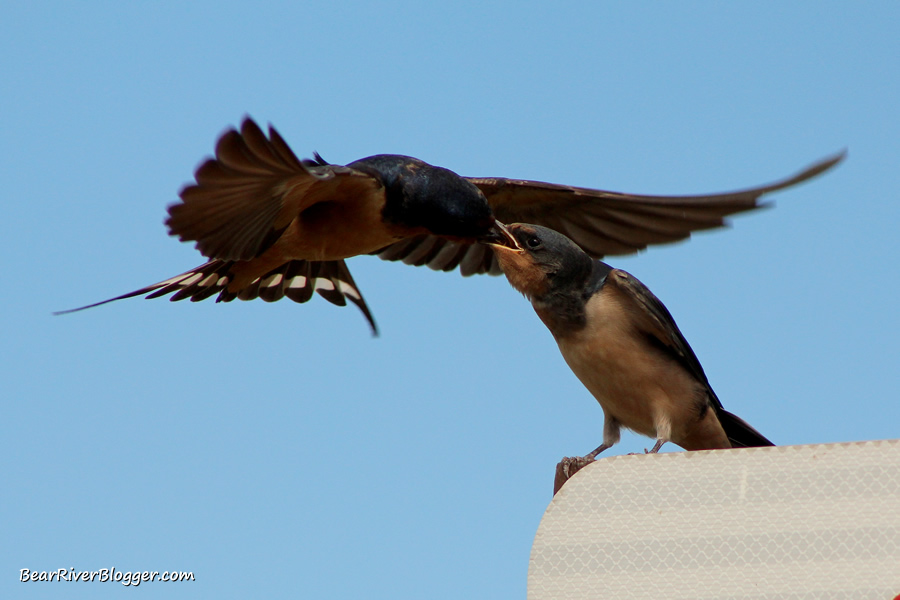
Conclusion
Having barn swallows in the yard can be both a treat and a nuisance, especially when their breeding efforts end up putting their nest in a most inconvenient and highly trafficked spot. Trust me, I know from numerous attempts over the years from barn swallows building nests in very poor locations around the house.
Barn swallows are small but they are tenacious protectors of the nest, and even though we mean them no harm with our intrusion into their space, they will indeed dive at you in an attempt to drive you away from the nest. The best thing to do is just give them their space for a few weeks and enjoy their company while they are around.
I personally enjoy the swallows nesting in my yard each summer and look forward to them returning for another breeding season next year as well.
If they return to and reuse the same nest from last season, so be it. I will just adjust what I do around the house so as not to be harassed by them or to disturb their nesting activities.
It’s a small inconvenience but having wild birds around the house is well worth the effort.
Subscribe to our blog
We appreciate your readership and suggest if you like this blog to head over to our subscription page and sign up for email notifications for future blog posts.
Bird Watching Apparel
If you’re looking for birding related gifts and apparel for someone, take a look at our online store featuring some of our own photographs turned into unique gifts.

As a reader of our blog, we offer you 20% off all products on our store by using the coupon code save20 during checkout.
Visit our Bird Shirts and More online store to check out our products. New products are constantly being added so check back often.

